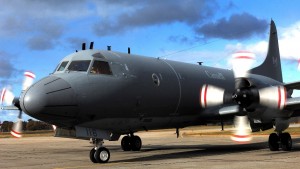September 2010. Heavy rains and high winds, the remnants of Hurricane Igor, buffet Newfoundland. Early reports tell of roads and bridges washed away, and communities isolated by rising water – but facts are hard to come by.
When a similar flood had hit Manitoba’s Red River Valley a few years before, the Royal Canadian Air Force sent a CP-140 Aurora west from Greenwood, Nova Scotia to survey the extent of the flood and assess the damage. Now, in 2010, as storms lash Newfoundland from Gambo to the Burin Peninsula, the air force dispatches one of the patrol planes north on a similar mission.
Potentially, lives are at stake. Time is of the essence.
Well, that was the theory. Unfortunately, while the Aurora could survey – and record – the devastating flooding, it had no way of sharing this material quickly. Seven anxious hours passed until the Aurora was back on the ground in Nova Scotia, and the images recorded by the aircraft’s sensors were readily available.
As Major Steve Fraser tells it, for LGen Yvan Blondin, now commander of the RCAF but at the time head of the 1st Canadian Air Division (and the Aurora’s “boss”), this was not good enough. This sort of information needed to be available in something closer to real time so that a commander on the ground or far away could see pretty much what the crew of the aircraft was seeing while they were seeing it.
The challenge, says Fraser, the operational equipment manager for the RCAF’s Aurora fleet, was that the Aurora’s “high frequency radios can’t carry that much data.” Visual information eats up bandwidth. To meet Blondin’s demands, another way had to be found.
The RCAF turned to L-3 Electronic Systems Services to develop what is called Beyond-Line-of-Sight (BLOS) transmission capability for the Aurora. The choice of L-3 ESS, as it is commonly called, was an easy one. Currently the prime contractor providing optimized weapons system support for the Aurora, the company is familiar with the aircraft and its systems.
The air force wanted a solution quickly. According to Richard Ackerman, vice-president of sales and marketing for L-3 ESS in Toronto, the RCAF demanded a critical design review three months after awarding the contract, with ground testing six months after that, and the first flight test taking place two months later.
L-3 ESS developed a BLOS system that took data from the aircraft’s various sensors and “packetized” it – compressed it, in the jargon of the industry. Rather than being transmitted by radio, these packets are bounced off an Inmarsat satellite, picked up by a ground station in Hawaii and then sent through the fibre-optic network, with, says Fraser, “slightly over a second delay” – virtually real time. Less urgent visual data can be sent as an email attachment.
On January 31, 2013, a CP-140 Aurora equipped with L-3 ESS’s BLOS system, successfully streamed live video back from just below 80 degrees north latitude in the Arctic to 14 Wing in Greenwood, a distance of nearly 4,000 kilometres. No RCAF aircraft had ever previously achieved this.
The possibilities for such a system extend well past such simple – if important – tasks as surveying floods and similar civil catastrophes. L-3 ESS’s BLOS system can send more than visual data. “For instance,” says Ackerman, “a CP-140 assisting a search and rescue on-scene commander in the High Arctic could transmit near-real time electro optic, infra-red, TV and voice data to the commander. The same blended data would be available for the plane’s crew and for the regional and national search and rescue centres.” L-3 ESS’s BLOS system can also transmit data gleaned via the Automatic Identification System (AIS) transmitter carried by all ocean-going vessels over 300 tons.
“Seeing is believing” may be a hoary cliché, but for the commander far removed from an action, it holds true. The more you can see – and faster – the more you can understand and the more effectively and quickly you can act.
L-3 ESS’s BLOS system seems to promise that. But it is still early days. January’s successful flight, says Major Fraser, “was just proof of concept.”
“Is this the system – or do we need something different?” says Fraser. There is still some way to go, Fraser says, before the entire Aurora fleet can be fitted with the new system, “despite the fact that everyone wants it now.”
Ian Coutts is a freelance writer, author of four books, and a frequent contributor to Vanguard. His writing has appeared in Toronto Life, Canadian Business, the Globe and Mail, and elsewhere.
